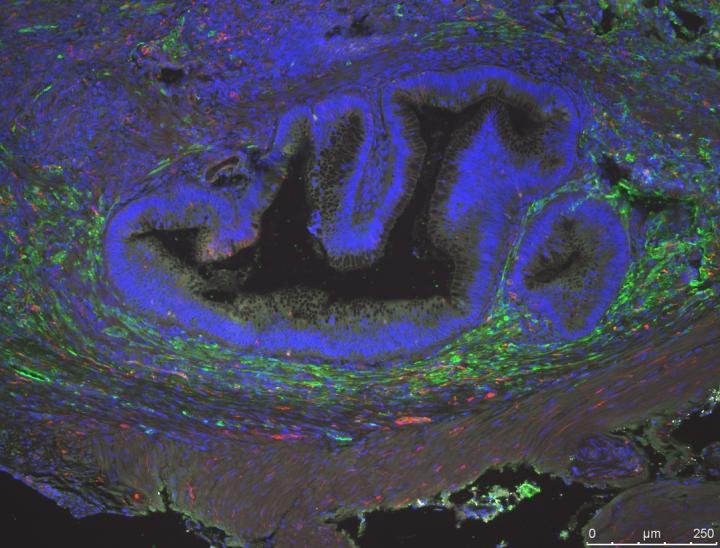Tissue-engineered colon from human cells develop different types of neurons

This is a tissue-engineered colon generated from cells from a patient with Hirschsprung's disease. Nerve cells (derived from neurospheres) are shown in green. Credit: Children's Hospital Los Angeles
These specialized neurons, localized in the gut, form the enteric nervous system, which regulates digestive tract motility, secretion, absorption and gastrointestinal blood flow. In addition, in a condition called Hirschsprung's disease or aganglionosis, where those neurons are not present, the team was able to replace them.
The study — the first report on the enteric nervous system in human-derived tissue-engineered colon — was published online ahead of print in the journal of Tissue Engineering, Part A on September 28.
In healthy intestines, food is moved along the digestive tract through peristalsis — a series of wave-like contractions. Special nerve cells called ganglion cells are required for this movement, but there is also a rich mixture of other types of nerve cells. In children with Hirschsprung's disease, these cells are missing. Without them, the intestine becomes blocked and surgical removal of the affected segment of colon is required.
To help these and other children suffering from intestinal diseases that may require surgical removal of all or part of their intestine, the CHLA team — led by principal investigator Tracy C. Grikscheit, MD, a pediatric surgeon and researcher at The Saban Research Institute of CHLA — is developing tissue-engineered options for these children.
One objective of growing tissue-engineered organs is to generate new tissue from a patient's own cells. Grikscheit and her team first needed to determine what parts of the enteric nervous system were present in tissue-engineered colon when it is grown from normal human cells.
“The diversity of neuron types that grew within the human tissue-engineered colon was a revelation to our team, because previously we had only documented that some ganglia were present,” said Grikscheit, who is also a tenured associate professor of Surgery at the Keck School of Medicine of the University of Southern California. “The next step was to determine if these neuronal elements could be supplied to tissue-engineered colon that was missing neurons – like in Hirschsprung's disease.”
The scientists initially grew cells from patients with Hirschsprung's disease and from mice with a genetic mutation that causes aganglionosis. In both cases, the tissue-engineered colon derived from these cells did not have the all-important components of the intestinal nervous system. In a second set of experiments, again testing both mouse and human cells, the investigators added neurospheres, which are clusters of purified neural progenitor cells. The cells had been stained with green fluorescence, so the scientists could readily visualize where the nerve cells ended up in the tissue-engineered colon, as well as determine the source of the nerve cells.
“After growing the colon for four weeks, we saw that the green nerve cells had been incorporated into the colon engineered from human tissue derived from a patient lacking those elements and that the different nerve subtypes were present,” said first author on the study, Minna Wieck, MD, an investigator and surgical resident at CHLA.
###
Additional contributors to the study include Wael N. El-Nachef, Xiaogang Hou, Ryan G. Spurrier, Kathleen A. Holoyda, Kathy A. Schall, Salvador Garcia Mojica, Malie K. Collins, and Andrew Trecartin of Children's Hospital Los Angeles; and Zhi Cheng, and Philip K. Frykman of Cedars-Sinai Medical Center, Los Angeles. Funding was provided in part by the California Institute of Regenerative Medicine (RN3 00946-1, RN3 06425, TG2-01168) and from the National Institute of Diabetes, Digestive and Kidney Diseases (K08DK090281).
Link to article: http://online.
About Children's Hospital Los Angeles
Children's Hospital Los Angeles has been named the best children's hospital in California and among the top 10 in the nation for clinical excellence with its selection to the prestigious U.S. News & World Report Honor Roll. Children's Hospital is home to The Saban Research Institute, one of the largest and most productive pediatric research facilities in the United States. Children's Hospital is also one of America's premier teaching hospitals through its affiliation since 1932 with the Keck School of Medicine of the University of Southern California. For more information, visit CHLA.org. Follow us on Twitter, Facebook, YouTube and LinkedIn, or visit our blog at http://researchlablog.
Media Contact
All latest news from the category: Life Sciences and Chemistry
Articles and reports from the Life Sciences and chemistry area deal with applied and basic research into modern biology, chemistry and human medicine.
Valuable information can be found on a range of life sciences fields including bacteriology, biochemistry, bionics, bioinformatics, biophysics, biotechnology, genetics, geobotany, human biology, marine biology, microbiology, molecular biology, cellular biology, zoology, bioinorganic chemistry, microchemistry and environmental chemistry.
Newest articles

NASA: Mystery of life’s handedness deepens
The mystery of why life uses molecules with specific orientations has deepened with a NASA-funded discovery that RNA — a key molecule thought to have potentially held the instructions for…

What are the effects of historic lithium mining on water quality?
Study reveals low levels of common contaminants but high levels of other elements in waters associated with an abandoned lithium mine. Lithium ore and mining waste from a historic lithium…

Quantum-inspired design boosts efficiency of heat-to-electricity conversion
Rice engineers take unconventional route to improving thermophotovoltaic systems. Researchers at Rice University have found a new way to improve a key element of thermophotovoltaic (TPV) systems, which convert heat…



